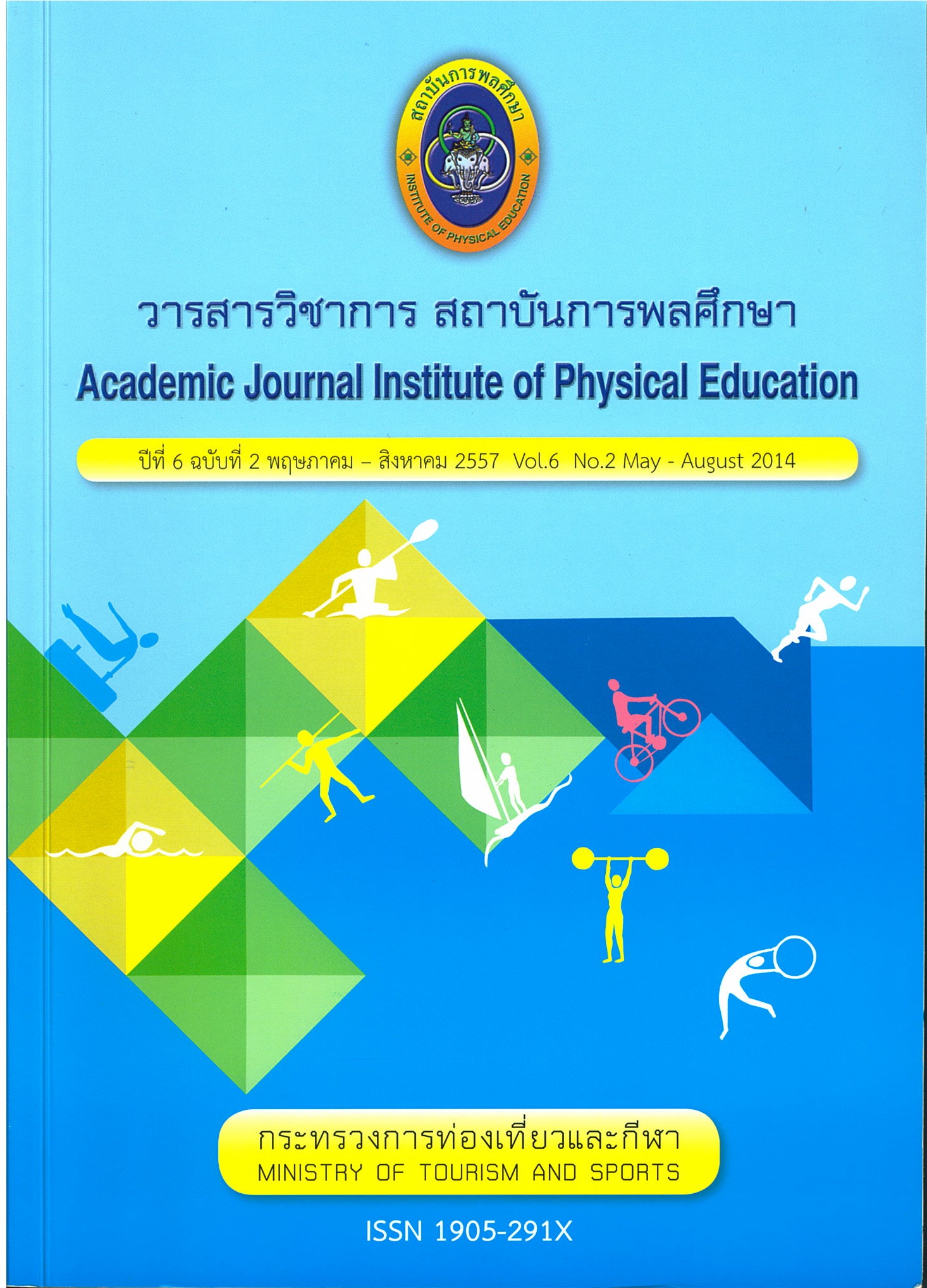The Relationship between Physical Environment and Venue Facilities for Aerobic on Aerobic Dance Exercise Behavior
Main Article Content
Abstract
This research aimed to investigate the relationship between physical environment and venue facilities for aerobic dance and aerobic dance exercise behavior. The sample of this study selected by cluster random sampling included 450 people who take aerobic exercises in Sukhothai Province and Phitsanulok Province. The obtained data were analyzed by means of percentages, means, standard deviation, chi - square tests, Peason product - moment correlation coefficient, exploratory factor analysis and multiple regression
The results of this research were as followed:
- The majority of the sample commuted to take aerobic exercises alone by bicycles/ motorcycles. They came to the aerobic place before the dance started and got 10-15 minutes rest after the dance. They got aerobic exercises 4 times a week
- The aerobic exercise behavior was not correlated with frequency of aerobic exercise at a .05 level of significance.
- The physical environment and venue facilit'es for aerobic dance were correlated
with frequency of aerobics exercise with no significart difference at .05 level.
- Physical environment and venue facility factors affected the frequency of aerobic exercises. It was found that three the best predicted variables that affected aerobic exercise behavior at the .05 level of statistic significance were: 1) the beautiful shady environment that included variables of tree trimming and shaping, landscape gardening and setting the place in harmony with nature, 2) the location suitable for aerobic exercises that included variables of area size, area layout and solid waste management, and 3) The ventilation of the area that included variables of the fresh air as well as circulation of air.
The recommendation from the research is that local agencies such as provincial administration organization or subdistrict administration organization in Sukhothai Province and Phitsanulok Province that involve in encouraging their people to take exercises for their good health should adapt the results of this research in providing the exercise venue with better physical environment and facilities in order to encourage people to take more exercises.
Article Details

This work is licensed under a Creative Commons Attribution-NonCommercial-NoDerivatives 4.0 International License.
The published article is a copyright of the Academic Journal of Thailand National Sports University. The passage appeared in each article in this academic journal is a perspective of each author which is not related to the journal. Each author is required to be responsible for all components of his/her own article. If there are any mistakes, each author must be responsible for those mistakes on his/her own.
References
กรมพลศึกษา, สํานักการกีฬา, แอโรบิกดานซ์บริหารกายเพื่อสุขภาพ. กรุงเทพฯ : กรมพลศึกษา, 2540.
ชาคริต เทพรัตน์, ปัจจัยที่ทํานายพฤติกรรมการออกกําลังกายของนักเรียนมัธยมศึกษาตอนต้น. วิทยานิพนธ์มหาบัณฑิต. ศึกษาศาสตร์ การส่งเสริมสุขภาพ) มหาวิทยาลัยเชียงใหม่, 2540.
ยุพาวรรณ วรรณวาณิชย์, การตลาดบริการ. กรุงเทพฯ : ธรรกมลการพิมพ์, 2548.
ธราดล เก่งการพานิช และมณฑา เก่งการพานิช. ทบทวนการจัดสิ่งแวดล้อมที่เอื้อต่อการออกกําลังกายและมาตรการทาง ภาษี, นนทบุรี, กองออกกําลังเพื่อสุขภาพ. กรมอนามัย กระทรวงสาธารณสุข, 2546.
ภาณุภาคย์ สุริยะกาญจน์. พฤติกรรมการออกกำลังกายของประชาชนที่มาออกกำลังกายด้วยการเต้นแอโรบิกส์ในบริเวณสวนหลวง ร.9. ปัญหาพิเศษทางการบริหารรัฐประศาสนศาสตรมหาบัณฑิต (การบริหารทั่วไป), วิทยาลัยการบริหารรัฐกิจ มหาวิทยาลัยบูรพา, 2532.
มนเฑียร อรรถจรรยา. (2543). แนวทางการออกแบบสภาพแวดล้อมที่ว่างในชุมชนเพื่อให้เกิดการรวมกลุ่มของผู้อาศัย : กรณีศึกษาคอนโดมิเนียมราคาประหยัด. (หน้า 40-42) วิทยานิพนธ์ ปริญญามหาบัณฑิต สาขาวิชาการออกแบบชุมชนเมือง บัณฑิตวิทยาลัย มหาวิทยาลัยศิลปากร, 2543.
นรเศรษฐ กมลสุทธิ์ และคณะ. ปัจจัยที่มีอิทธิพลต่อพฤติกรรมการตัดสินใจสมัครสมาชิกฟิตเนสเซ็นเตอร์, รายงานการค้นคว้าด้วยตัวเอง, ภาควิชาการตลาด, มหาวิทยาลัยสยาม, 2550.
สุภาภรณ์ พลนิกร, พฤติกรรมผู้บริโภค. พิมพ์ครั้งที่ 2. กรุงเทพฯ: โฮลิสติก พับลิบซึ่ง
Golany, Gideon S. Ethics and Urban Design: Culture, Form. and Environment. New York: John Wiley and Sons, 1995.
Taylor & Miller. (1994). Aerobic Leader Fitness A life tie Commitment. in American Fitness 3rd ed. London: M.N. Burgess. pp. 40.
Whyte, William H. The Social Life of Small Urban Spaces. Washington, D.C. : Conservation.
Foundation,1980. Yamaguchi, y., and Okada, K. (1988). A study of adherence to a fitness club: A user's perspective. Abstracts New Horizons of Human Movement. 128.


